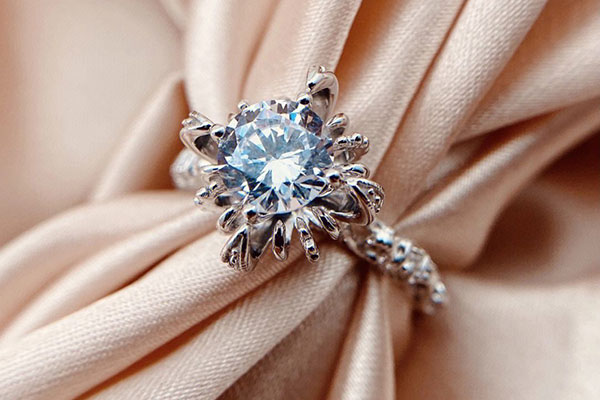The Stomach Meridian of Foot-Yangming is one of the twelve meridians,which is distributed on the front of the body, starting from ST 1(Chengqi) point under the eyes and going down to ST 45(Lidui) point on the feet,There are 45 points on one side of the meridian, 15 points on the anterior and outer sides of lower limbs,30 points on the abdomen, chest, and head and face,which is commonly used for gastrointestinal and other digestive system, nervous system, respiratory system, circulatory system diseases and throat, head and face, mouth, teeth, nose and other diseases.
Stomach Meridian Point Pathway
There are two main lines and four branch lines along the Stomach Meridian. Among the meridians of the body, it is the meridian with the most branches.
The Stomach Meridian starts from the side of the nose and goes upward with the nose. The left and right sides connect to the base of the nose,passes into the inner canthus of the eye, intersects with the Bladder Meridian, and goes along the outside of the nasal and into the upper teeth,encircle the lips, intersect with RN 24(Chengjiang) point, along the posterior and edge of the mandible to ST 5(Daying) point, go up the mandibular, and pass through GB 3(Shangguan) point, along the hairline, to the forehead.
The branch of Stomach Meridian goes from the front of ST 5(Daying) point to ST 9(Renying) point, goes down the throat and back to DU 14(Dazhui), folds forward, enters the pelvis to ST 12(Quepen) point, belonging to the stomach, and connect to spleen,goes straight and down:
- One branch is from ST 12 going out of the body surface, down along the midline of the breast,along away 2 cun the umbilicus on both sides, and down to ST 30(Qichong) point.
- Two branch is from KI 21(Youmen), down along the abdominal cavity to ST 30(Qichong) point, converge with the Du Channel, and then down on the front of thigh to the knee and patella, along the front edge of lower limb tibia to the back of foot to ST 45(lidui) point.
- Three branch is from 3 cun below the knee (ST 36 Zusanli point) and decends into the outer end of middle toe.
- Four branch is from ST 42(Chongyang) point,goes forward into the inner side of big toe (SP 1 Yinbai point), and connects to the Spleen Meridian.
Stomach Meridian Point Location
ST 1 Acupuncture Point(Chengqi)
Location:Below the pupil, between the eyeball and the infraorbital ridge.
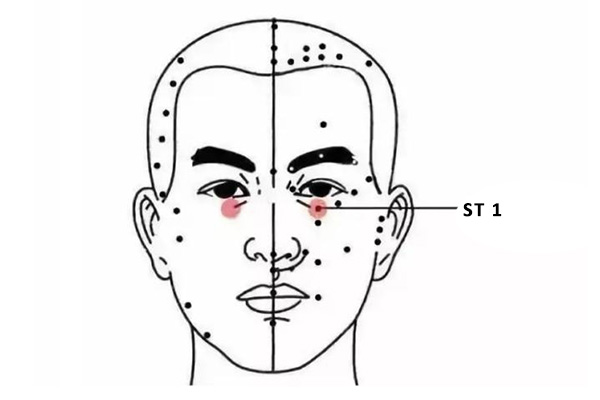
Usage:
- Swelling and pain of eye, epiphora with wind, eyelid tremulous, facial paralysis.
- Myopia, night blindness, tremor, blepharospasm, keratitis, optic atrophy, eye fatigue,presbyopia, cataracts and other eye diseases.
Clinical:Conjunctivitis, myopia, hyperopia, astigmatism. Glaucoma, strabismus, cataract, optic atrophy, facial nerve palsy, hemifacial spasm, etc.
Location:Below the pupil, in a depression at the infraorbital foramen.
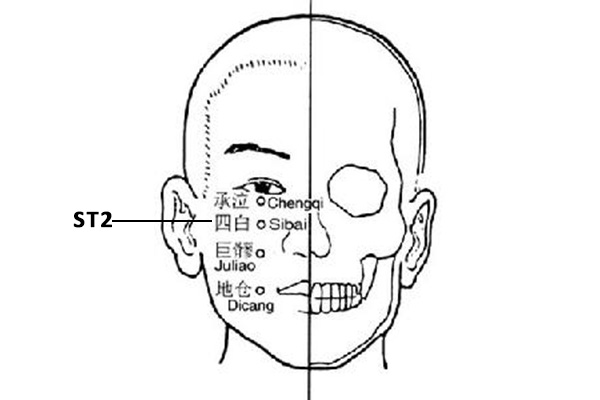
Usage:
Swelling and pain of eyes, nephelium, eyelid movement, facial paralysis, headache and dizziness;
Clinical:Eye diseases such as myopia and color blindness;
ST 3 Acupuncture Point(Juliao)
Location:Directly below the pupil in a depression at the level of the border of the ala nasi.
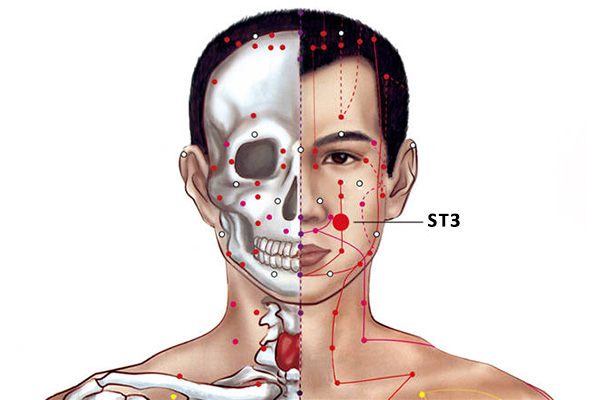
Usage:Facial paralysis, eyelids tremulous, epistaxis, toothache, swollen lips and cheeks.
Clinical:Facial nerve palsy, trigeminal neuralgia, toothache, rhinitis, etc.
ST 4 Acupuncture Point(Dicang)
Location:Directly below the pupil, lateral to the corner of the mouth.
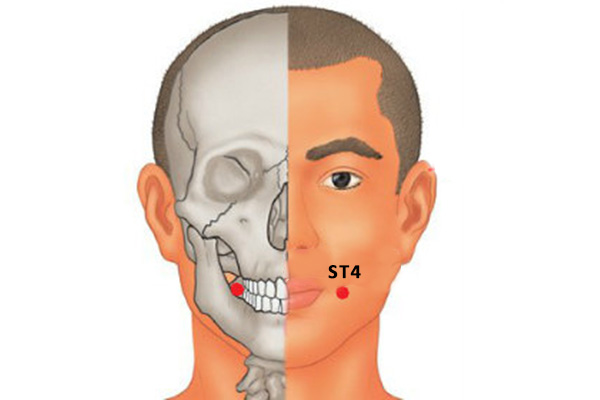
Usage:Paralysis, salivation, eyelid tremulous, toothache, cheek swelling;
Clinical:Facial nerve palsy, trigeminal neuralgia.
ST 5 Acupuncture Point(Daying)
Location:Anterior to the angle of the mandible on the anterior border of the masseter muscle in a groove-like depression (facial artery groove), with cheeks bulged.
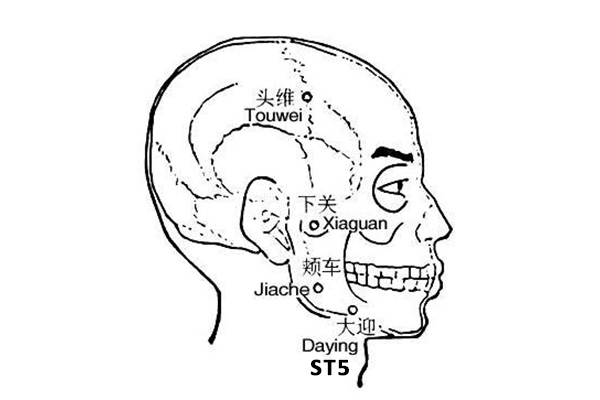
Usage:
- Tooth pain, swollen cheeks, lockjaw, face swelling, facial pain, facial paralysis;
- Dental caries pain, pericoronitis of the wisdom tooth, facial cellulitis, blepharospasm, cervical lymph node tuberculosis.
- Facial nerve palsy, hemifacial spasm, trigeminal neuralgia.
ST 6 Acupuncture Point(Jiache)
Location:One finger width anterior and superior to the angle of the mandible at the belly of the masseter muscle with teeth clenched.
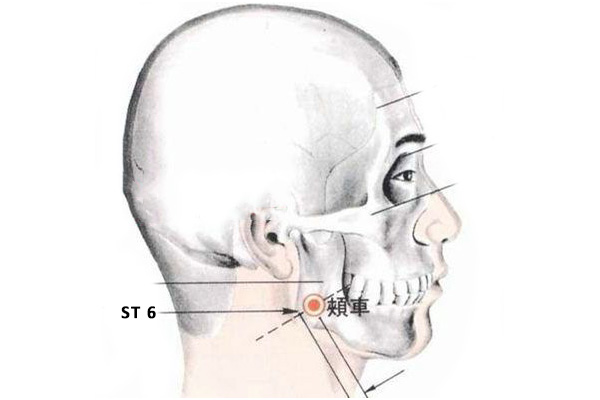
Usage:Facial paralysis, facial nerve palsy, mumps, hoarseness, buccal inflammation, toothache, facial spasm, etc.
Clinical:Facial nerve palsy, trigeminal neuralgia, temporomandibular arthritis, parotitis, etc.
ST 7 Acupuncture Point(Xiaguan)
Location:On the face, anterior to the ear, in a depression between the zygomatic arch and the mandibular notch, with mouth closed.
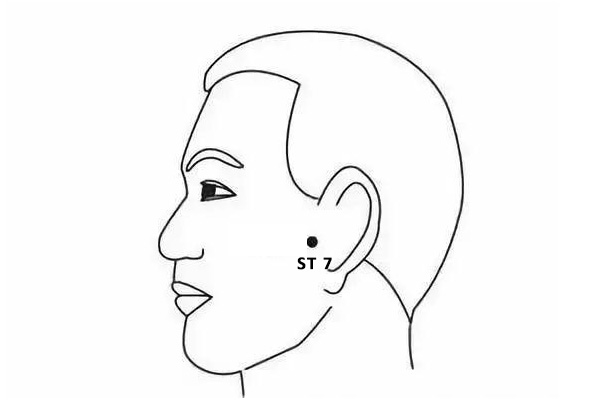
Usage:
- Deafness, tinnitus,tympanitis;
- Toothache, lockjaw, temporomandibular arthritis.
- Facial paralysis, facial pain, trigeminal neuralgia, facial nerve palsy, mandibular pain etc;
ST 8 Acupuncture Point(Touwei)
Location:Directly above ST 7, .5 cun within the anterior hairline at the corner of the forehead, 4.5 cun lateral to the midline of the head (GV 24).
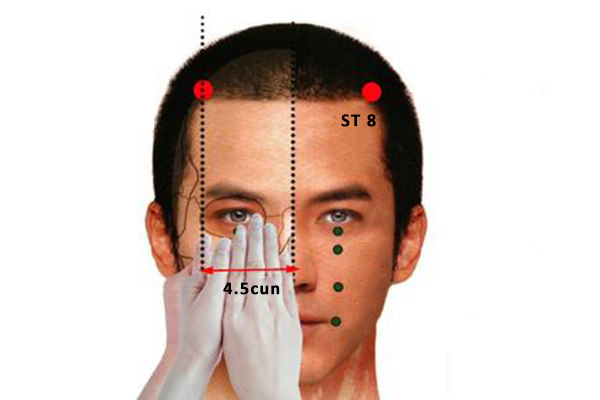
Usage:Migraine,headache,vomiting and sweating,epiphora with wind, unclear vision, schizophrenia, high blood pressure, conjunctivitis, dizziness, etc.
Clinical:Angio-neural headache, orbicularis muscle spasm, etc.
ST 9 Acupuncture Point(Renying)
Location:Level with the tip of the Adam’s Apple on the anterior border of the sternocleidomastoideus muscle (where the pulse of the common cartoid artery is felt).
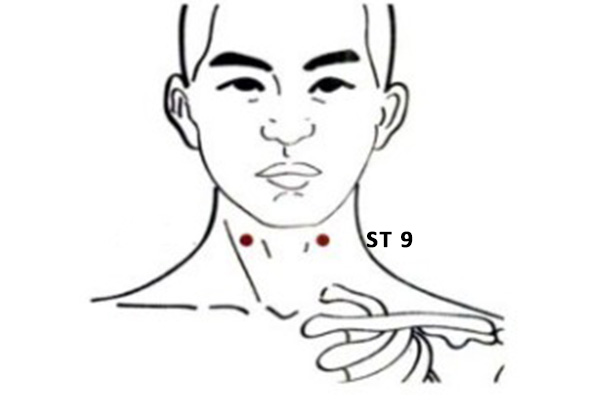
Usage:
- Sore throat, bronchitis, bronchitis, asthma, thyroid disease;
- Chest fullness, loss of appetite, high blood pressure.
ST 10 Acupuncture Point(Shuitu)
Location:Midway between ST 9 and ST 11 at the anterior border of the sternocleidomastoideus muscle.
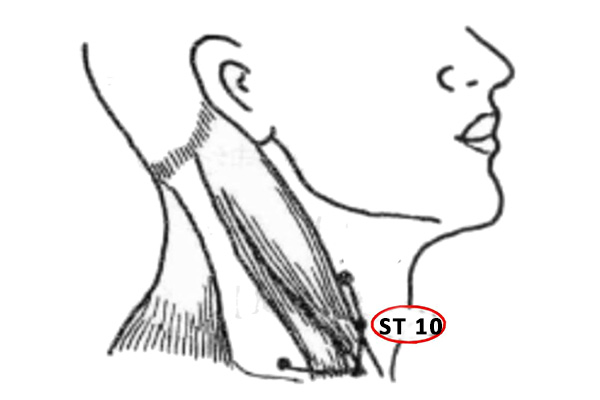
Usage:Sore throat, cough, wheezing.
Clinical:Tonsillitis, goiter, bronchitis, bronchial asthma, etc.
ST 11 Acupuncture Point(Qishe)
Location:At the superior border of the clavicle between the sternal and clavicular heads of the sternocleidomastoideus muscle.
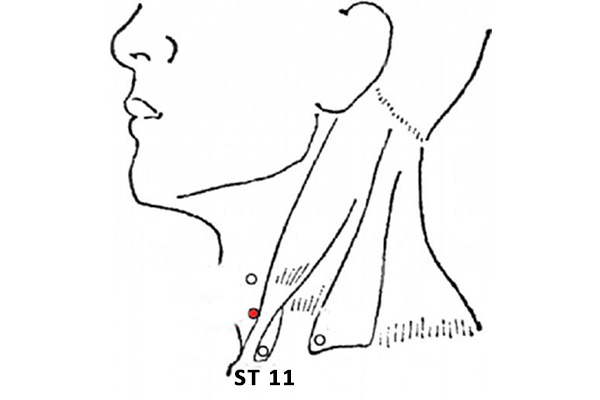
Usage:
Swelling and pain of throat, acute stiff neck, cough, asthma, scrofula, etc;
Clinical:
1. Respiratory system diseases: pharyngitis, tonsillitis, laryngitis, bronchitis, asthma, whooping cough;
2. Digestive system diseases: esophagitis, diaphragmatic spasm, dyspepsia;
3. Others: cervical lymph node tuberculosis, goiter, stiff neck, cervical spondylosis.
ST 12 Acupuncture Point(Quepen)
Location:In the midpoint of the supraclavicular fossa, 4 cun lateral to the anterior midline.
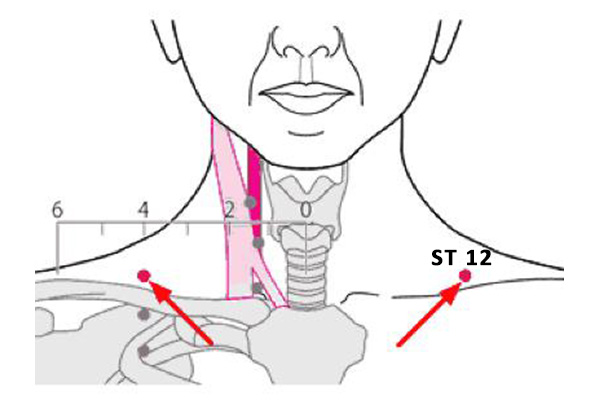
Usage:Cough, wheezing, pelvic pain, fullness chest,throat disorder, scrofula,thyroid disease and other diseases;
Clinical:
1. Respiratory diseases: tonsillitis, bronchitis, bronchial asthma, pleurisy;
2. Others: diaphragmatic spasm, cervical lymphatic tuberculosis, goiter, shoulder soft tissue disease.
Location:4 cun lateral to the AML at the lower border of the clavicle.
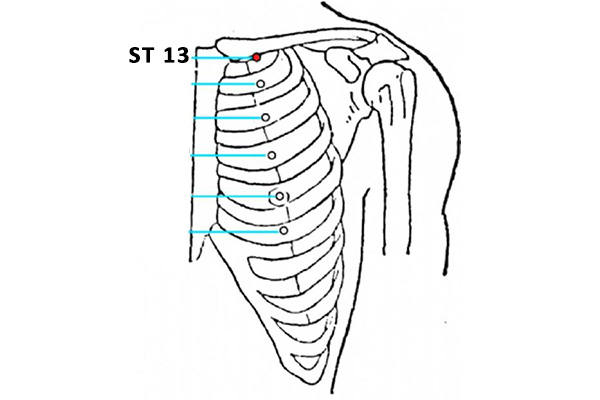
Usage:Cough, wheezing, hiccups, fullness of chest and thigh, chest pain.
Clinical:
1. Respiratory system diseases: chronic bronchitis, asthma, pleurisy;
2. Others: costochondritis, intercostal neuralgia.
ST 14 Acupuncture Point(Kufang)
Location:4 cun lateral to the AML in the 1st ICS.
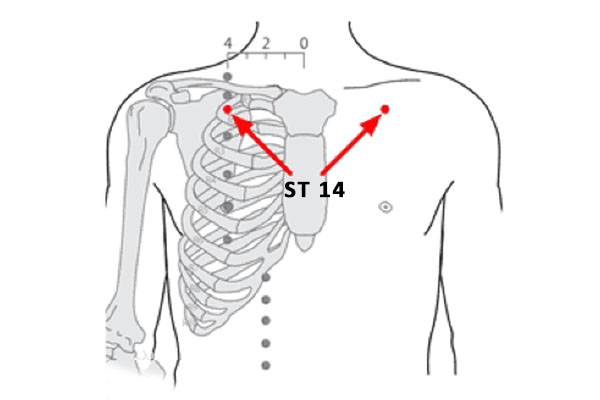
Usage:Cough, wheezing, chest pain, coughing and hematemesis;
Location:4 cun lateral to the AML in the 2nd ICS.
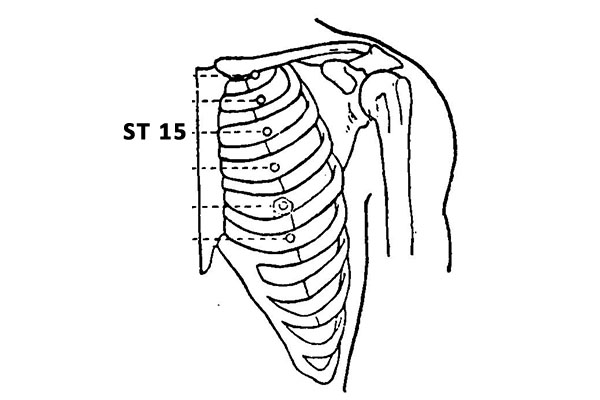
Usage:Cough, wheezing, pyohemoptysis, sternocostal pain,mastitis;
ST 16 Acupuncture Point(Yingchuang)
Location:4 cun lateral to the AML in the 3rd ICS.
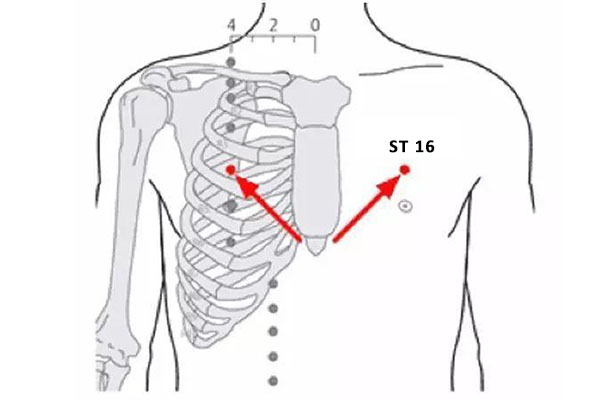
Usage:Cough, wheezing, sternal pain, mastitis;
Clinical:Bronchitis, bronchial asthma, mastitis, intercostal neuralgia.
ST 17 Acupuncture Point(Ruzhong)
Location:4 cun lateral to the AML in the 4th ICS.
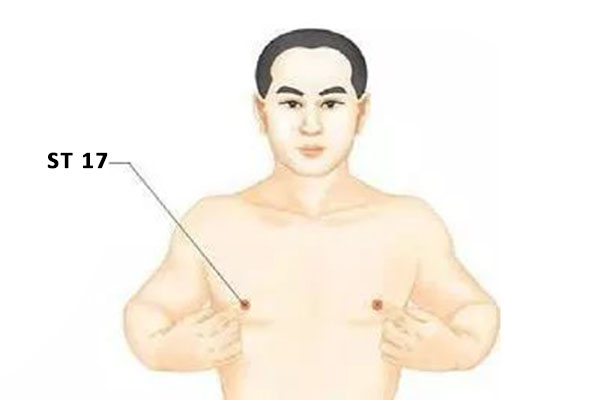
- Usage:Never needled or treated, simply a body landmark for locating points on the chest for men;
- It can treat women’s breast diseases.
ST 18 Acupuncture Point(Rugen)
Location:4 cun lateral to the AML in the 5th ICS.
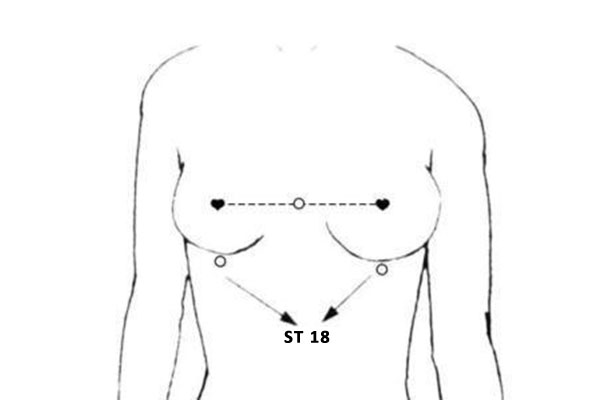
Usage:Mastitis, chest pain, arm swelling and pain, cough, poor milk secretion, breast swelling and pain.
Clinical:
- Breast enhancement, alleviation and treatment of mastitis, poor milk secretionetc.;
- Relieve cough, wheezing, hiccups, chest pain, asthma, chronic bronchitis, pleurisy, etc.
ST 19 Acupuncture Point(Burong)
Location:2 cun lateral to the AML level with CV 14.
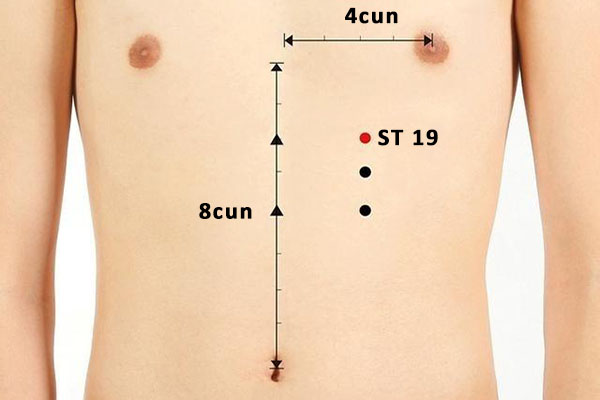
Usage:Stomach pain, vomiting, loss of appetite, anorexia, chronic gastritis, gastroptosis, peptic ulcer, etc.
Clinical:Gastritis, gastric dilatation, vomiting, indigestion, abdominal pain, cough, asthma, intercostal neuralgia, spasm or atrophy of shoulder and arm muscles;
ST 20 Acupuncture Point(Chengman)
Location:2 cun lateral to the AML level with CV 13.
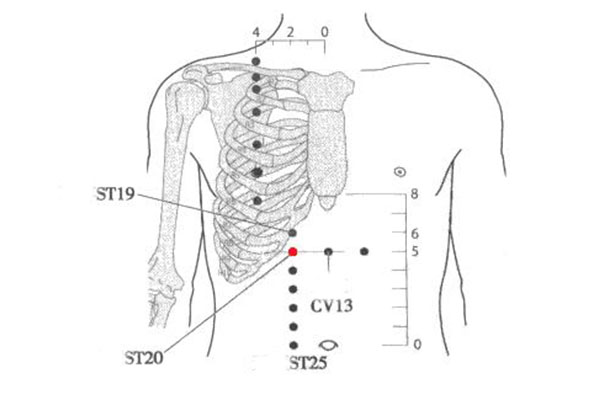
Usage:Stomach pain,hematemesis, loss of appetite, abdominal distension.
Clinical:Gastroduodenal ulcer, stomach cramps, acute and chronic gastritis, dyspepsia, gastric neurosis, peritonitis, hepatitis, dysentery, enteritis.
ST 21 Acupuncture Point(Liangmen)
Location:2 cun lateral to the AML level with CV 12.
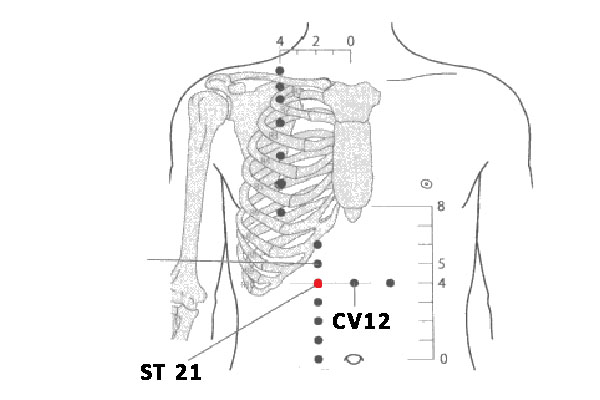
Usage:Stomach pain, vomiting, anorexia, diarrhea, and peptic ulcer disease, acute and chronic gastritis, gastroptosis, etc.
Clinical:Gastritis, gastric or duodenal ulcer, gastroptosis, gastric neurosis.
ST 22 Acupuncture Point(Guanmen)
Location:2 cun lateral to the AML level with CV 11.
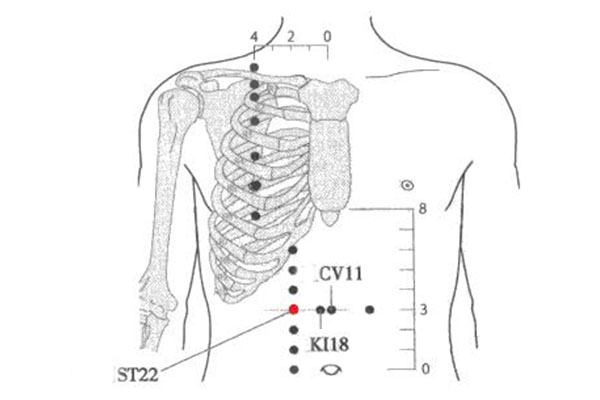
Usage:Abdominal pain, abdominal gaseous distension, borborygmus, diarrhea, loss of appetite, swelling
Clinical:Acute and chronic gastritis, acute and chronic enteritis.
ST 23 Acupuncture Point(Taiyi)
Location:2 cun lateral to the AML level with CV 10.
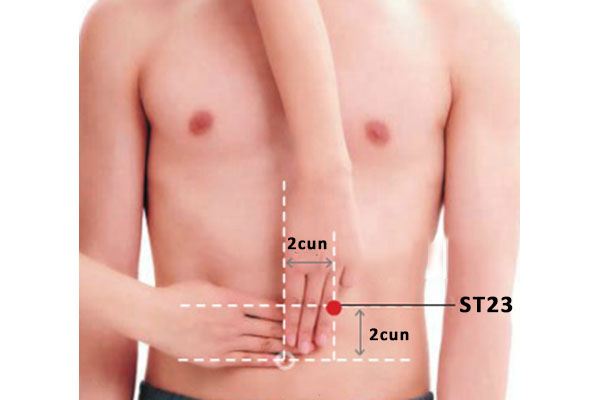
Usage:abdominal pain, bloating, upset, madness and other mental disorders;
ST 24 Acupuncture Point(Huaroumen)
Location:2 cun lateral to the AML level with CV 9.
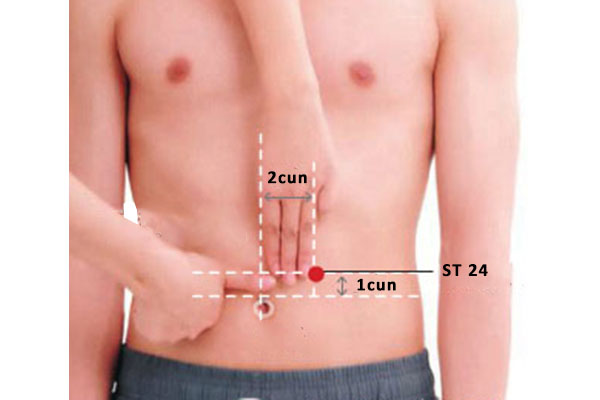
Usage:Stomach pain, vomiting, hiccups, bowel, diarrhea, madness, etc.
ST 25 Acupuncture Point(Tianshu)
Location:2 cun lateral to the center of the umbilicus.
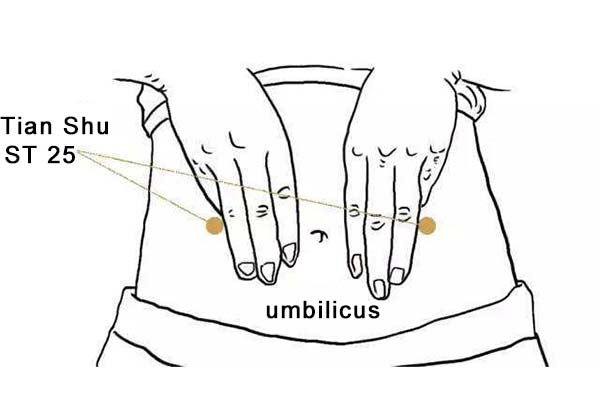
Usage:
1. Abdominal pain, bloating, constipation, diarrhea, dysentery and other gastrointestinal diseases.
2. Gynecological diseases such as irregular menstruation and dysmenorrhea.
Clinical:Acute and chronic gastritis, acute and chronic enteritis, appendicitis, enteroparalysis, bacillary dysentery, dyspepsia, urinary calculi, irregular menstruation, appendicitis, endometritis, nephritis, edema, high blood pressure, low back pain, pediatric convulsions, Biliary ascariasis and so on.
ST 26 Acupuncture Point(Wailing)
Location:2 cun lateral to the AML level with CV 7.
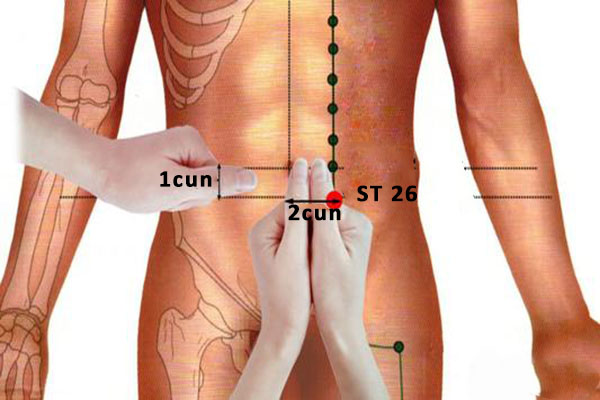
Usage:abdominal pain, hernia, dysmenorrhea;
Clinical:Appendicitis, ureteral stones, etc.
Location:2 cun lateral to the AML level with CV 5.
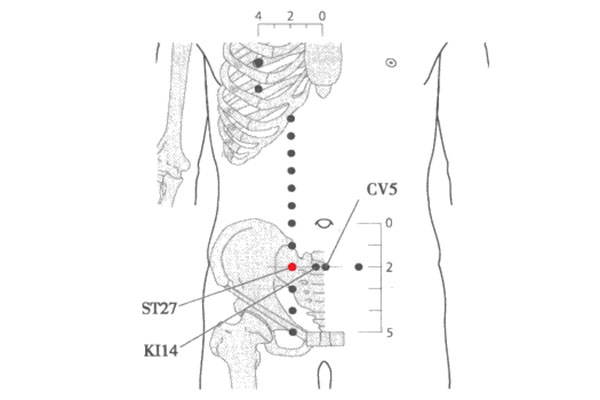
Usage:Abdominal pain, diarrhea, abdominal distension, difficulty in urination;
Clinical:Rectus abdominis spasm, intestinal obstruction, cystitis, urinary retention, etc.
ST 28 Acupuncture Point(Shuidao)
Location:2 cun lateral to the AML level with CV 4.
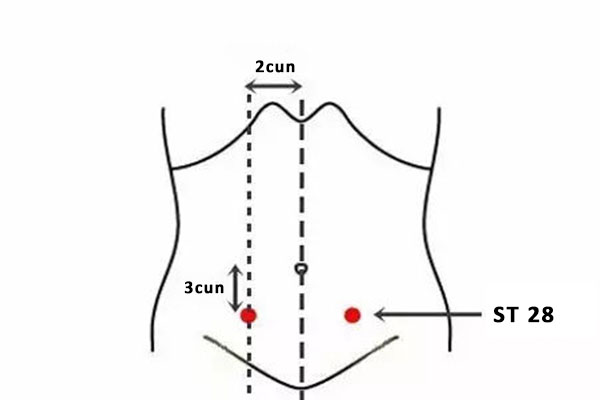
Usage:fullness of lower abdomen,difficulty urinating, dysmenorrhea, infertility, hernia etc;
Clinical:Nephritis, cystitis, urinary retention, oophoritis, etc.
ST 29 Acupuncture Point(Guilai)
Location:2 cun lateral to the AML level with CV 3.
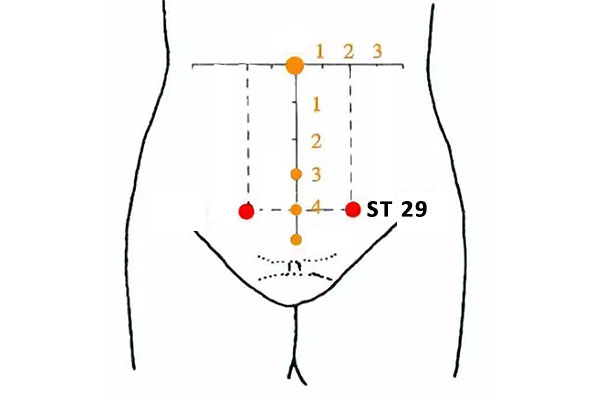
Usage:Abdominal pain, hernia, irregular menstruation, amenorrhea, metrorrhagia, vaginal discharge, Uterine prolapse, nocturnal emission, impotence, etc;
Clinical:Orchitis, penile pain, endometritis, oophoritis, infertility, postpartum persistent lochia, inguinal hernia in children, genital diseases.
ST 30 Acupuncture Point(QiChong)
Location:2 cun lateral to the AML level with CV 2.
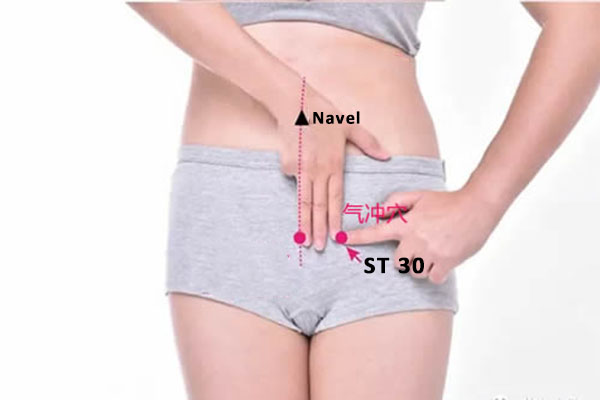
Usage:hernia,swelling and pain of testicular, dripping urination, irregular menstruation, abduction, dystocia, nocturnal emission, impotence, etc.
Clinical:
1. Diseases of the genitourinary system: urinary system infection, prostatitis, orchitis, hernia;
2. Obstetrics and gynecology system diseases: dysmenorrhea, irregular menstruation, functional uterine bleeding, infertility.
ST 31 Acupuncture Point(Biguan)
Location:On 2 lines connecting the ASIS and the superiolateral corner of the patella and level with the lower border of symphysis pubis in a depression with thigh flexed lateral to the sartorius muscle.
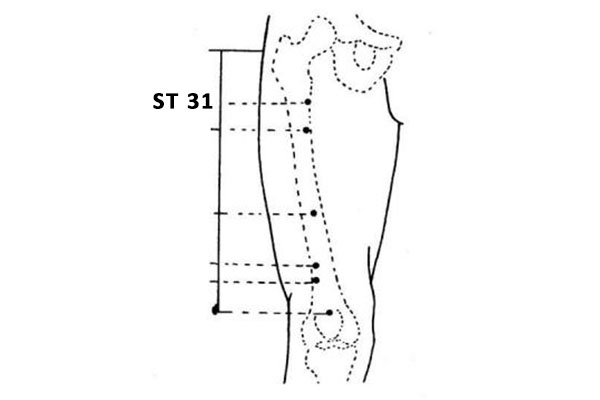
Usage:Knee (hip, thigh) pain, paralysis,swelling and pain of leg, lower limb numbness, poor flexion and extension of lower limb, lateral femoral cutaneous neuritis, etc.
Clinical:Paralysis of lower limbs, inguinal lymphadenitis, lateral femoral cutaneous neuritis, knee arthritis.
Location:6 cun above the superior lateral border of the patella on the line connecting with the ASIS.
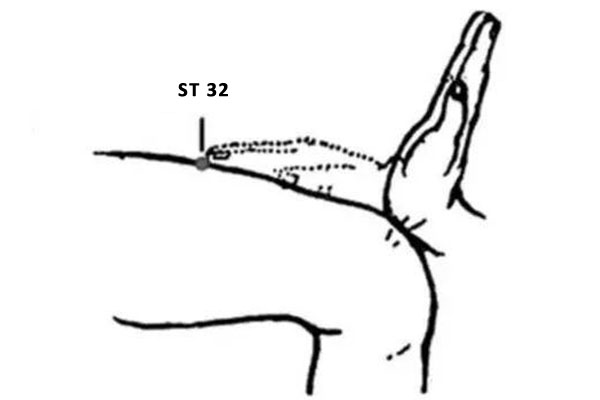
Usage:
- Low back pain, coldness of the waist and the knee, paralysis of lower limbs, hernia, abdominal distension, abdominal pain, athlete’s foot and other symptoms;
- Knee arthritis, urticaria, inguinal lymphadenitis and other diseases.
ST 33 Acupuncture Point(Yinshi)
Location:With knee flexed, 3 cun above the superior lateral border of the patella on line connecting with the ASIS.
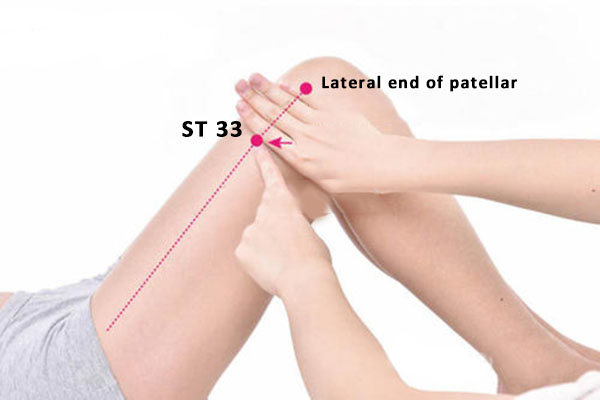
Usage:knee joint and surrounding soft tissue diseases, knee joint pain, paralysis of leg and knee, poor extension and flexion, lower extremity swelling, athlete’s foot, low back pain, abdominal distension, and abdominal pain;
ST 34 Acupuncture Point(Liangqiu)
Location:With knee flexed, 2 cun above the superior lateral border of the patella on the line connecting with the ASIS.
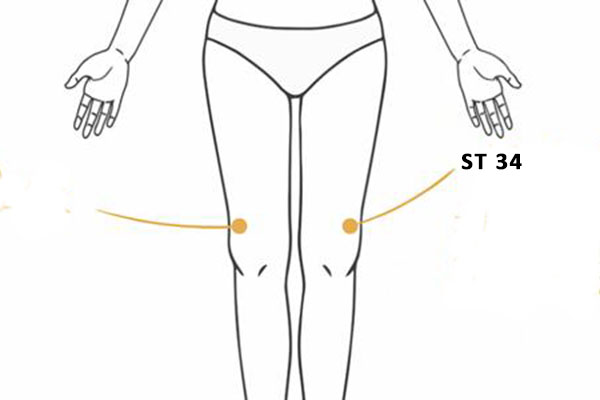
Usage:Acute stomach pain, mastitis, hematuria,swelling and pain of knee, paralysis of the lower limbs and other diseases
Clinical:Stomach cramps, mastitis, knee joint disease, etc.
Location:With knee flexed, below the patella in a depression lateral to the patellar ligament.
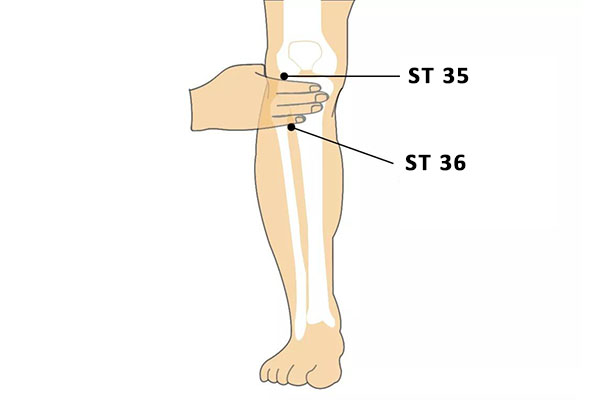
Usage:Leg pain, knee arthritis,paralysis of lower extremity , athlete’s foot, edema, weakness of knee and foot, abdominal distension, and constipation.
Clinical:Various knee joint pains such as rheumatism, rheumatoid arthritis, knee osteoarthritis, trauma, etc.
ST 36 Acupuncture Point(Zusanli)
Location:3 cun below ST 35, one finger width lateral from the anterior border of the tibia.
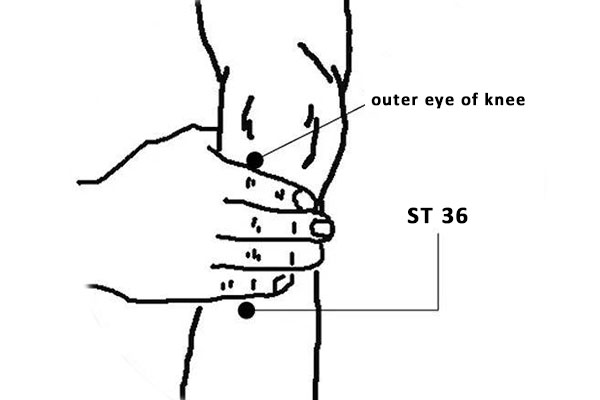
Usage:
- Stomach pain,Vomiting,Abdominal distension, Bowel, indigestion, Acute and chronic gastritis, Gastric ulcer ,Neuralgia
- Digestive system diseases: stomach pain, abdominal distension, hiccups, vomiting, indigestion, diarrhea, constipation, dysentery, acute and chronic pancreatitis, appendicitis, acute and chronic gastroenteritis, hepatitis, biliary diseases.
- Various chronic diseases and deficiency syndromes:fatigue, palpitations, shortness of breath, dizziness, coughing and wheezing, recovery from serious illness
- Skin diseases: acne, chloasma, rubella, neurodermatitis, urticaria.
- Diseases of ENT: facial paralysis, facial spasm, trigeminal neuralgia, tinnitus, deafness, eye disease, nasal disease.
- Paralysis of lower limbs: sequelae of stroke and hemiplegia, numbness of hands and feet, knee joint disease, sciatica, inability to limb lifting.
- Improve immunity, and anti-aging.
- Others: such as insomnia, madness, high blood pressure, hypotension, irregular menstruation, infertility, low back pain, edema, athlete’s foot, mastitis, breast hyperplasia, heart disease, respiratory diseases, leukopenia, arteriosclerosis, etc.
Clinical:Acute and chronic gastroenteritis, duodenal ulcer, gastroptosis, dysentery, appendicitis, intestinal obstruction, hepatitis, hypertension, hyperlipidemia, coronary heart disease, angina pectoris, rheumatic fever, bronchitis, bronchial asthma, nephritis, renal colic , Bladder inflammation, impotence, nocturnal emission, functional uterine bleeding, pelvic inflammatory disease, shock, insomnia, etc.
ST 37 Acupuncture Point(Shangjuxu)
Location:6 cun below ST 35, one finger width lateral from the anterior border of the tibia.
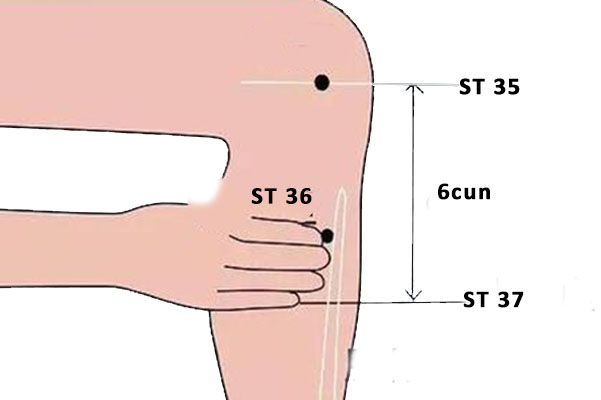
Usage:Diarrhea, appendicitis, gastroenteritis, pain and fullness of abdominal, dysentery, bacillary dysentery, constipation,soreness of knee and tibia , knee swelling and pain, paralysis of lower limbs, athlete’s foot, etc.
Clinical:Bacterial dysentery, acute enteritis, appendicitis, etc.
ST 38 Acupuncture Point(Tiaokou)
Location:8 cun below ST 35, one finger width lateral from the anterior border of the tibia.
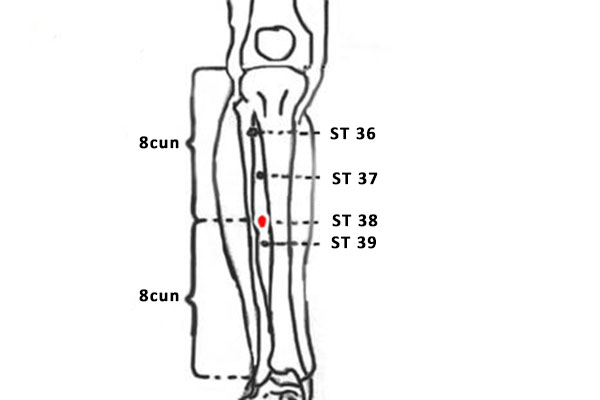
Usage:Paralysis of lower limbs, muscle cramps, shoulder and arm pain, abdominal pain.
Clinical:Frozen shoulder, knee arthritis, paralysis of lower limb, stomach pain, enteritis, tonsillitis, etc.
ST 39 Acupuncture Point(XiaJuxu)
Location:9 cun below ST 35, one finger width lateral from the anterior border of the tibia.
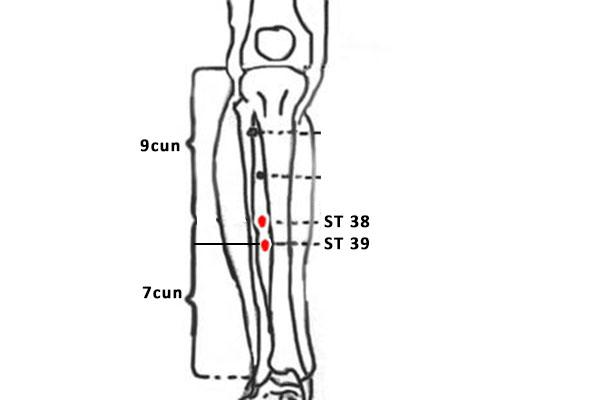
Usage:Diarrhea, dysentery, abdominal pain and other gastrointestinal syndromes, paralysis of lower limbs, and acute mastitis;
Clinical:Bacterial dysentery, acute and chronic enteritis, paralysis of lower limbs, etc.
ST 40 Acupuncture Point(Fenglong)
Location:8 cun below ST 35, one finger width lateral to ST 38, two finger widths lateral to the anterior border of the tibia.
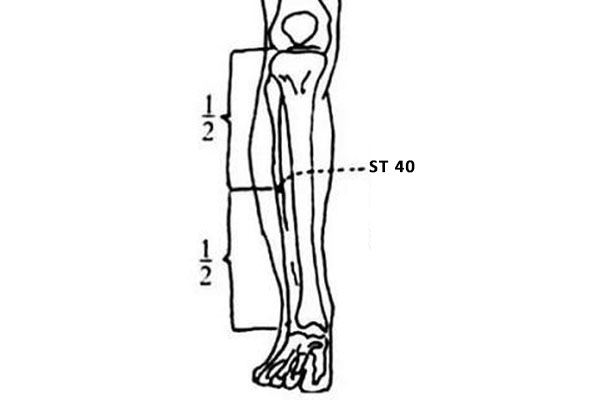
Usage:Headache, dizziness, cough and phlegm, wheezing, chest pain, madness, epilepsy, edema of lower limbs, soreness of legs and knees, paralysis of lower limbs, hypertension, etc.
Clinical:Meniere’s syndrome, hypertension, hyperlipidemia, neurasthenia, schizophrenia, bronchitis, gastrocnemius spasm, obesity, etc.
ST 41 Acupuncture Point(Jiexi)
Location:On the midpoint of the transverse crease of the ankle, approximately level with the tip of the external malleolus, in a depression between the tendons of extensor digitorum longs and hallucis longus.
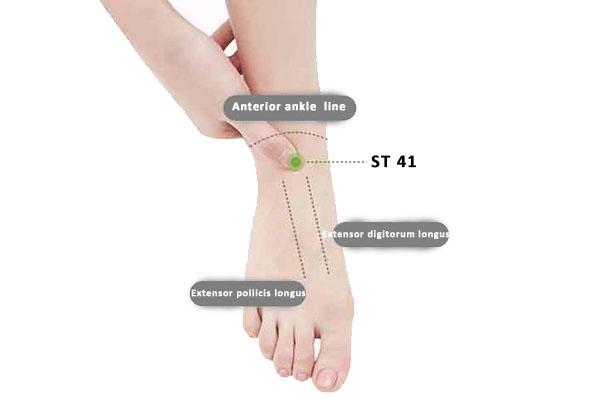
Usage:
- Headache, dizziness, madness.
- Bloating, constipation.
- Paralysis of lower limbs, swelling and pain of ankles.
Clinical:Foot drop, neuropathic headache, gastroenteritis, ankle joint and surrounding soft tissue diseases, etc.
ST 42 Acupuncture Point(Chongyang)
Location:Between the 2nd and 3rd metatarsals and the cuneiform bone, between the tendons of the long extensor muscles of the big toe and other toes.
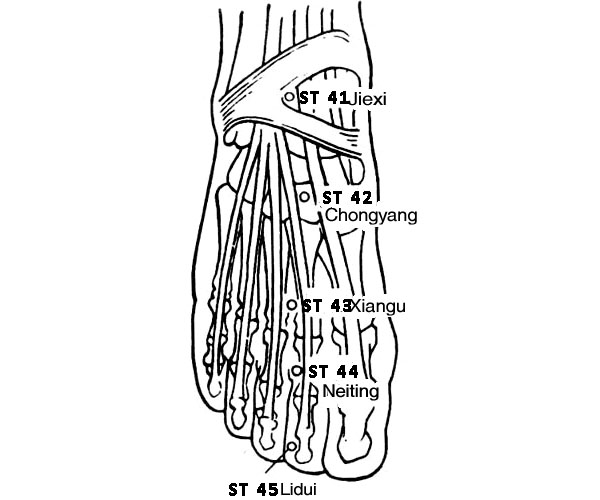
Usage:Stomach pain, bloating,toothache, face swelling,Swelling and pain in the back of foot, and weakness of the foot.
Clinical:
1. Mental nervous system diseases: facial nerve palsy, dizziness;
2. Digestive system diseases: stomach cramps, gastritis;
3. Movement system diseases: rheumatoid arthritis, sprained foot;
4. Others: toothache.
ST 43 Acupuncture Point(Xiangu)
Location:In a depression distal to the junction of the 2nd and 3rd metatarsal bones.
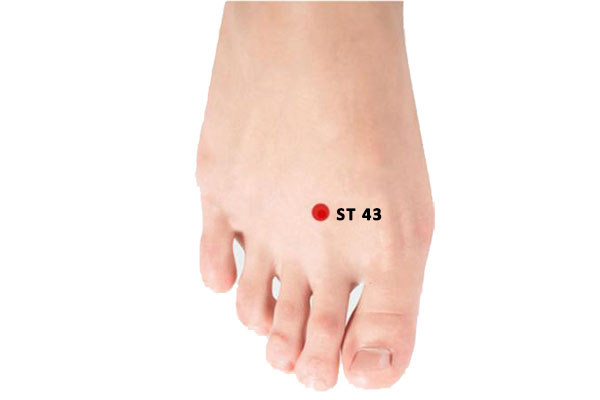
Usage:Abdominal pain, fullness of abdominal, bowel, diarrhea, swelling of face, swelling and pain of eye, hernia, swelling and pain in the back of foot, etc.
Clinical:Colds, pleurisy, gastritis, enteritis, nephritis. Paralysis of lower limbs, sprained foot.
ST 44 Acupuncture Point(Neiting)
Location:Proximal to the web margin between the 2nd and 3rd metatarsal bones, in a depression distal and lateral to the 2nd metatarsodigital joint.
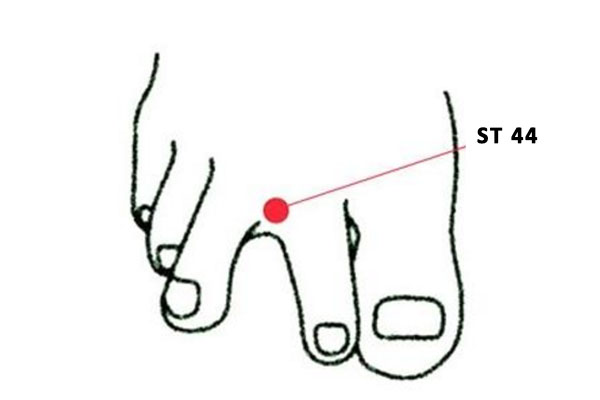
Usage:Toothache throat,facial paralysis, epistaxis,acid regurgitation, abdominal distension, diarrhea, dysentery, constipation, fever, swelling and pain of foot and back, etc.,
Clinical:Acute and chronic gastritis, acute and chronic enteritis, gingivitis, tonsillitis, toe and plantar joint pain, etc.
ST 45 Acupuncture Point(Lidui)
Location:0.1 cun posterior to the corner of the nail on the lateral side of the 2nd toe.
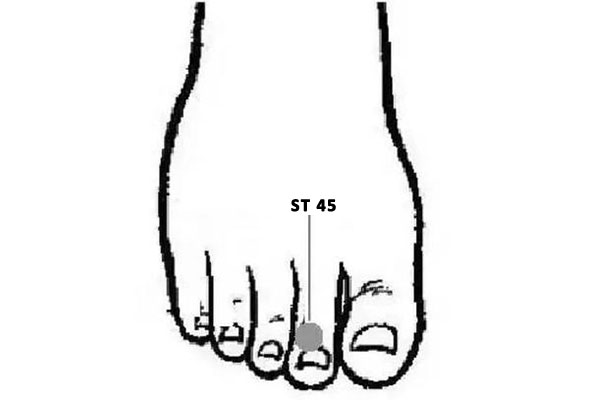
Usage:Toothache, facial paralysis, throat swelling and pain, epistaxis, mania, fever, swelling and pain in the back of foot and other diseases etc.
